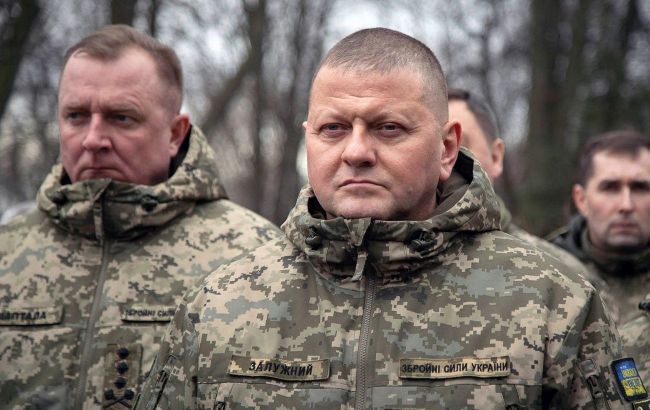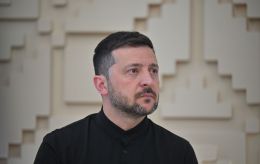'It was my mistake': Ukrainian Commander-in-Chief on counteroffensive and 'gunpowder' for victory
 Commander-in-Chief of the Armed Forces of Ukraine, Valerii Zaluzhnyi (Photo: facebook.com)
Commander-in-Chief of the Armed Forces of Ukraine, Valerii Zaluzhnyi (Photo: facebook.com)
The war with Russia has reached an impasse, and a massive technological leap is needed to break out of it. As the protracted conflict is advantageous primarily to the enemy rather than us.
About the mistake made by Zaluzhnyi, why the counteroffensive of the Armed Forces of Ukraine did not go as expected in the west, and how to get out of the deadlock and prevent a protracted trench warfare - in the article by the Commander-in-Chief of the Armed Forces of Ukraine for The Economist.
Regarding the counteroffensive by the Ukrainian Armed Forces and the mistake
In five months of the counteroffensive, Ukraine managed to advance only 17 kilometers. For ten months, Russia fought around Bakhmut "to take a town six by six kilometers." The battlefield resembles a significant conflict of ancient times.
Just like in the First World War, we have reached the level of technology that puts us into a stalemate. There will most likely be no deep and beautiful breakthrough.
The authors of the news agency wrote that "the course of the counter-offensive has undermined Western hopes that Ukraine could use it to demonstrate that the war is unwinnable—and thus change Vladimir Putin’s calculations, forcing the Russian president to negotiate. It has also undercut General Zaluzhnyi’s assumption that he could stop Russia by bleeding its troops".
That was my mistake. Russia has lost at least 150,000 dead. In any other country, such casualties would have stopped the war. But not in Russia, where life is cheap and where Mr Putin’s reference points are in the first and second world wars in which Russia lost tens of millions.
An army of Ukraine’s standard ought to have been able to move at a speed of 30km a day as it breached Russian defensive lines. “If you look at nato’s text books and at the maths which we did [in planning the counter-offensive], four months should have been enough time for us to have reached Crimea, to have fought in Crimea, to return from Crimea and to have gone back in and out again, General Zaluzhnyi says sardonically. Instead, he watched his troops and equipment get stuck in minefields on the approaches to Bakhmut in the east, his Western-supplied equipment getting pummelled by Russian artillery and drones.
As Zaluzhnyi expressed it, he initially thought, "There was something wrong with our commanders, so I changed some of them."
But when these changes did not yield results, I "ordered subordinates to find a book that I saw as a military academy student." Its title was "Breaching Fortified Defence Lines," published in 1941 by Soviet Major General P.S. Smirnov, who analyzed the battles of World War I.
And before I got even halfway through it, I realized that is exactly where we are because just like then, the level of our technological development today has put both us and our enemies in a stupor.
The war has reached an impasse
The general confirmed that he recently visited the front line in Avdiivka, where Russia advanced several hundred meters in a few weeks, deploying two of its armies there.
On our monitor screens, the day I was there, we saw 140 Russian machines ablaze—destroyed within four hours of coming within firing range of our artillery. Those fleeing were chased by "first-person-view" drones, remote-controlled and carrying explosive charges that their operators simply crash into the enemy. The same picture unfolds when Ukrainian troops try to advance.
The simple fact is that we see everything the enemy is doing, and they see everything we are doing. In order for us to break this deadlock we need something new, like the gunpowder which the Chinese invented and which we are still using to kill each other.
This time, however, the decisive factor will be not a single new invention but a combination of all the technical solutions that already exist, he says.
F-16s are already less useful
Western allies have been overly cautious in supplying Ukraine with their latest technology and more powerful weapons. Joe Biden, America’s president, set objectives at the start of Russia’s invasion: to ensure that Ukraine was not defeated and that America was not dragged into confrontation with Russia.
This means that arms supplied by the West have been sufficient in sustaining Ukraine in the war, but not enough to allow it to win. General Zaluzhnyi is not complaining: "They are not obliged to give us anything, and we are grateful for what we have got, but I am simply stating the facts."
By withholding the supply of long-range missile systems and tanks, the West allowed Russia to regroup and establish defense after a sudden breakthrough in the Kharkiv region in the north and in the Kherson region in the south at the end of 2022.
These systems were most relevant to us last year, but they only arrived this year. Similarly, F-16 jets, due next year, are now less helpful, suggests the general, in part because Russia has improved its air defenses: an experimental version of the s-400 missile system can reach beyond the city of Dnipro.
Ukraine is stuck in a war where Russia has the advantage
Instead, technology in the war will be decisive. The general is enthusiastic about recent conversations with former Google executive Eric Schmidt and emphasizes the crucial role of drones and electronic warfare systems that can interfere with their flights.
Zaluzhnyi's assessment contradicts this: there are no signs of a revolutionary technological breakthrough in the drone or electronic warfare field just around the corner.
Even in the First World War, the arrival of tanks in 1917 was not sufficient to break the deadlock on the battlefield: it took a suite of technologies and more than a decade of tactical innovation to produce the German blitzkrieg in May 1940.
The implication is that Ukraine is stuck in a long war—one in which he acknowledges Russia has the advantage. Nevertheless, he insists that Ukraine has no choice but to keep the initiative by remaining on the offensive, even if it only moves by a few meters a day.
Ukraine has already hit Crimea with ATACMS missiles
Crimea remains the most vulnerable place for dictator Vladimir Putin. According to The Economist, over the past few months, Ukraine has brought the war to the peninsula, which Putin occupied in 2014 and which remains critically essential for the logistics of his war.
It is the linchpin of his imperial restoration project, and his legitimacy rests on having brought it back to Russia.
According to Zaluzhnyi, the first long-range American missile strikes on Russian positions in the temporarily occupied peninsula were carried out on October 30.
It must know that it is part of Ukraine and that this war is happening there.
What is the risk of trench warfare?
The Chief of the General Staff of the Armed Forces of Ukraine desperately tries not to let the war settle into trenches.
The biggest risk of an attritional trench war is that it can drag on for years and wear down the Ukrainian state.
In the First World War, mutinies interfered before technology could make a difference. Four empires collapsed, and a revolution broke out in Russia.
A collapse in Ukrainian morale and Western support is precisely what Mr Putin is counting on. There is no question in General Zaluzhnyi’s mind that a long war favors Russia, a country with a population three times and an economy ten times the size of Ukraine’s.
Let’s be honest, it’s a feudal state where the cheapest resource is human life. And for us…the most expensive thing we have is our people.
For now, General Zaluzhnyi has enough soldiers. But the longer the war lasts, the harder it will be to continue.
We need to look for this solution, we need to find this gunpowder, quickly master it and use it for a speedy victory. Because sooner or later we are going to find that we simply don’t have enough people to fight.

